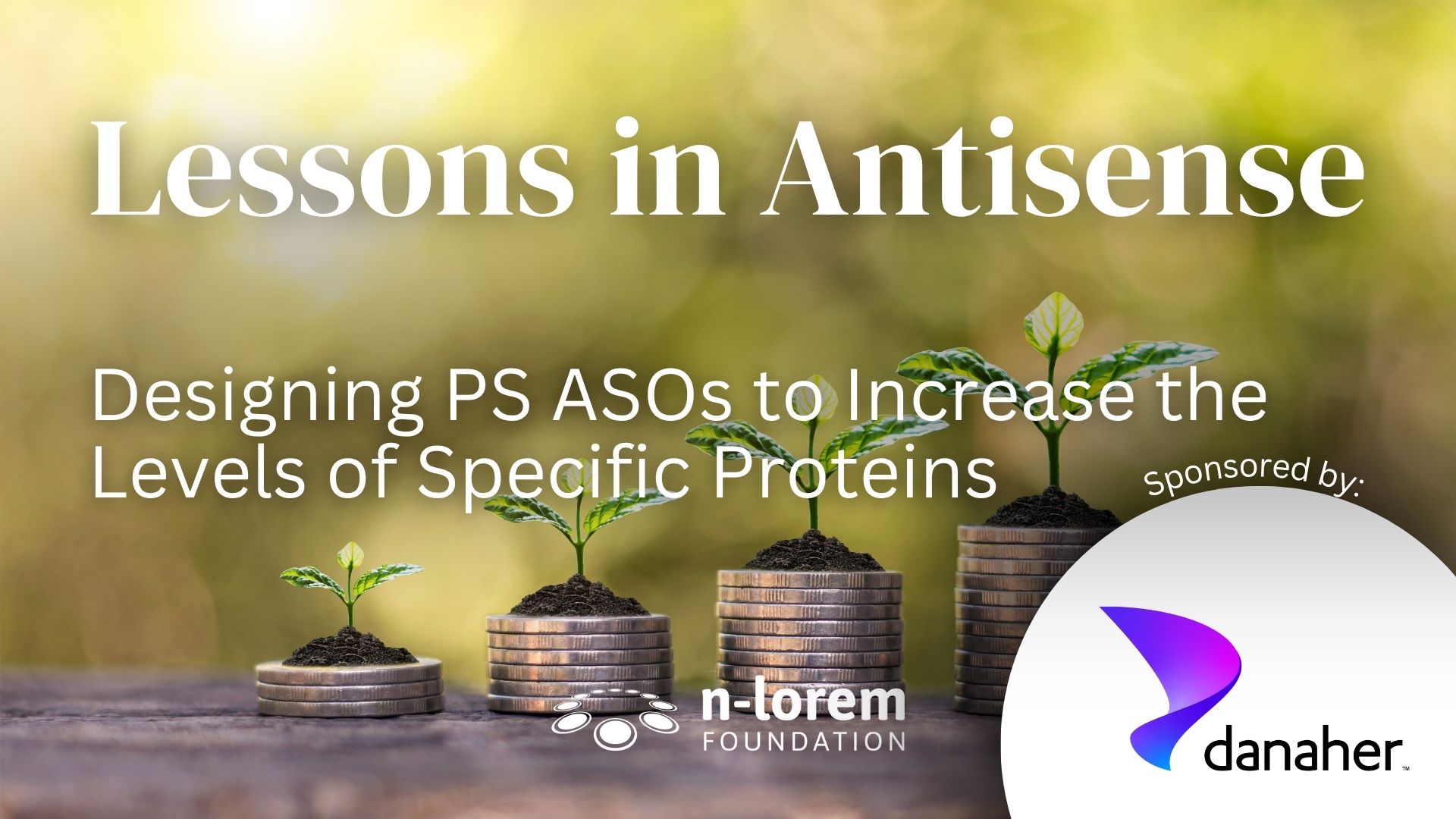Lessons in Antisense
Lesson 20 – Designing PS ASOs to Increase the Levels of Specific Proteins
October 6, 2025 by Dr. Stan Crooke

Introduction
About 40% of all medicines that have been discovered are “agonists or agonist-like.” An agonist is a chemical that induces a positive biological response. A good example is epinephrine or adrenaline. Epinephrine and many chemicals derived from epinephrine can bind to one of the receptors for epinephrine, the B-adrenergic receptor, stimulate it to cause the cell to make more c-AMP and dilate bronchioles. So, many drugs used to treat asthma are B-adrenergic agonists. A fundamental weakness of ASO technology is that most ASOs are designed to block the function of RNAs or degrade the RNA, preventing it from doing the work it is designed to do. Such ASOs are antagonist-like. Given that we are anxious to make ASO technology as broadly useful as possible, we have invested in learning how to design ASOs to enhance the production of specific proteins.
Cells must constantly respond to changes in their environments and since proteins are the molecules cells use to the work of the cell, the levels of most proteins are carefully regulated. Recent progress has identified multiple mechanisms the cell uses to alter the levels of specific proteins. Although it has long been known that protein levels can be adjusted by changing the rate of transcription or alternative splicing, more recently, several mechanisms that regulate the rate of translation of specific proteins have been uncovered. Specifically, it has been suggested that alternative poly-A site use might alter the stability of some m-RNAs and consequently the levels of the proteins encoded by the mRNA. Further, a variety of stressors have been shown to alter the levels of many proteins. A useful way to think of the various mechanisms that regulate the levels of select proteins is that they constitute a temporally integrated network to respond to cellular stress. Altering the rate of degradation or changing the rate of translation are the most rapid means of adjusting protein levels and can be thought of as “first responders” to stress. Adjusting the levels of specific mRNAs via alternative splicing or altered poly-A site usage can be considered the second stage of the integrated response to stress, while increasing transcription is the slowest means of adjusting protein levels and might be thought of as the “last responders” to stress.
mRNAs regulate their own processing and translation
Each mRNA has a specific set of sequence and structural elements that control their own processing and translation and many of these “architectural features” are now known and, more are being unearthed at a rapid pace. A third feature of mRNAs in addition to sequence elements and structure is RNA modifications. RNAs are frequently chemically modified after transcription, and these chemical modifications also serve as signals for regulatory pathways and processes. The simplest way to think about sequence elements, RNA structures and RNA modifications is that they are recognition elements used to attract specific RNA binding proteins, other RNAs or, most frequently, RNA-protein (RNPs) complexes.
RNA sequence elements
RNA sequence elements can be as simple as two nucleotides such as adenosine followed by guanosine (AG) which is a signal to assemble the very complex RNP machine that initiates splicing of mRNA to polypyrimidine tracts (runs of cytidine and uridine) to sequences that are used to mark the part of the RNA that is actually used to synthesize the protein, the Kozak sequence (GCC(G or A)CCAUGG) also referred to as the protein translation initiation site. Irrespective of how complex a sequence element is, such sequences are used to recruit proteins or RNPs that can be as complex as a ribosome.
RNA structures
Some proteins prefer to bind to single–stranded RNA while others prefer double–stranded or more complex RNA structures. Most RNA structures result from an RNA folding back on itself hybridizing using Watson-Crick base pairing. The simplest types of structures are called stem-loops in which the stem is double–stranded, and the loop is single stranded – you can think of the structure as like a lollypop. In addition to providing signals to attract certain types of proteins, such structures can also impede translation because the RNA has to be single stranded for the ribosome to read the RNA code for each amino acid that is added to build the protein.
RNA modifications
There are many types of chemical modifications that can be engineered by the cell in an RNA, and the modifications can occur in the information containing part of RNA, the nucleo-bases or the inter-nucleotide linker, the ribose. A very common modification is to add a methyl group to the ribose sugar. This is called a 2’methoxy because it occurs in the 2’ position of the ribose and replaces a hydrogen with a methyl group bound to an oxygen (methoxy). Another common modification is to add a methyl group at position 6 in adenosine (m6A). Such modifications “mark” the RNA and are recognized by specific proteins or RNP complexes.
Cryptic splice sites and alternative splicing
Almost all mRNAs must be processed from much longer pre-mRNAs by clipping out portions of the pre-mRNA, then re-ligating the RNA (hence the term splicing). This provides the opportunity for a single gene to encode several proteins. The primary processing path, that is what sections of the pre-mRNA are edited out, is defined by the strength of each set of splicing signals. In this way, the gene provides directions to the splicing machinery about what protein to make under normal conditions, yet make a different protein if needed under stressful conditions. Weaker splice signals are often referred to as cryptic splice sites. ASOs can be used to block primary splice sites which then can allow cryptic splice sites to be used to create an m-RNA that encodes a different protein. Altering splices use has been an effective mechanism for ASOs for some time.
Poly-A sites and RNA stability
All pre-mRNAs are stabilized by chemically modifying both ends of the RNA. Since RNAs are read left-to-right just as English is read and the left end of the RNA begins at the 5’ site in the ribose, the left end is called the 5’ end and the right end is called the 3’ end of the RNA. The 5’ end is modified chemically to make it less prone to degradation by the enzymes that degrade RNA, nucleases. At the 3’, a stretch of nucleotides rich in adenosine (A) is added as a stabilizer and a specific enzyme is used to add the “poly–A” stretch of nucleotides. Each pre-mRNA contains at least one sequence, the poly-A site that is used to tell the enzyme to add the stretch of A rich nucleotides at that position. Many pre-mRNAs have more than one poly–A site and, once again, the strength of the signal can vary. The primary poly-A site defines how stable the pre-mRNA is under normal conditions while secondary poly-A sites define different levels of stability in response to various stress conditions or fine tune of expression in certain tissues such as neuronal, thus regulating how much protein is made. My lab showed that ASOs can be used to block primary poly-A sites causing secondary poly-A sites to be used, and that can alter the stability of the RNA to enhance or reduce the amount of protein made.
ORFs and uORFs
The ribosome, which is the protein making machine of the cell, identifies a particular sequence, the Kozak sequence, to identify the starting point to make a protein. The coding sequence that is used to make a protein is called an “open reading frame (ORF, because it is available for the ribosome to roll down the RNA, read the RNA code and convert that to a protein. Many mRNAs have sequences that look like Kozak sequences prior to the real Kozak sequence that marks the beginning of the protein to be made. Since these fake Kozak sequences come before the real Kozak sequences, they are called “upstream open reading frames (uORFs). uORFs act as decoys to fool ribosomes to start at that point, thus reducing the amount of protein translated by the ribosome. They suppress the making of the protein under normal conditions, but during stress, they are blocked allowing more of the protein to be made. My lab showed that we can design ASOs to bind to uORFs and thus increase the production of proteins.
Translation Inhibitory Elements
Translation inhibitory elements (TIEs) are stem loop structures that typically are located in in the 5’ untranslated region of an mRNA. Because RNA is structured, the ribosome is inhibited from moving beyond the TIE, thus reducing translation of the protein. Once again, my lab showed that ASOs could be designed to disrupt TIE structures and enhance translation of the encoded protein.
MicroRNAs
MicroRNAs (miRNAs) are naturally occurring 21 nucleotide RNAs that can alter the production of specific proteins in at least two ways. miRNAs bind to sites in the 3’ untranslated region (3’UTR) of mRNAs. Binding selectivity is defined primarily by a core 8 nucleotide sequence in the middle of each miRNA. If base pairing with the target RNA is more extensive, that is, it extends toward the 3’end of the RNA, miRNAs can recruit an argonaut protein (Ago), an RNase, to degrade the mRNA, thus reducing the production of the protein. Alternatively, less base-pairing can lead to inhibition of translation. Significant effort has been invested in designing ASOs to bind to miRNAs as a means of enhancing translation of the encoded protein with some limited success.
Nascent inhibitory peptides
More recently, nascent inhibitory peptides have been identified that can reduce translation of the protein encoded by the mRNA or inhibit the translation of other mRNAs. As a protein is translated by the ribosome (actually, the working assembly line has multiple ribosomes on an mRNA translating multiple copies of the encoded protein and is called a polysome), the protein that is being made is growing one amino acid at a time extending backwards from the ribosome and some peptides can bind to the mRNA and impede ribosome movement down the mRNA. Some of these peptides have also been shown to bind to other mRNAs and inhibit translation of protein encoded by a different mRNA.
Other mechanisms
Recent work has demonstrated significant variation in the rate of translation and the number of ribosomes used to translate different mRNAs. As the differences in translation rate and ribosome density cannot be explained by known mechanisms, it seems likely that there are other mechanisms of regulating translation to be discovered.
Challenges in designing PS ASOs to increase the levels of specific proteins
Though we have pioneered the research that supports designing “agonist-like” PS ASOs, taking full advantage of many of these mechanisms remains challenging.
Taking advantage of cryptic splice sites
Though we have successfully designed PS ASOs to alter splicing for some time and Spinraza is an important medicine to treat SMA and a commercial success, the design of splice altering ASOs could be more facile if the molecular mechanisms by which ASOs alter splicing were better understood. Simply identifying important and therefore desirable cryptic splice sites is challenging because there are many weak splicing signals spread throughout the pre-mRNA landscape. We are now exploring ways to take advantage of new insights into how cryptic splice sites are used to respond to changes in the environment and new tools to identify important cryptic splice sites. More fundamentally, we know that when an ASO binds to a site in a pre-mRNA and successfully redirects splicing, the ASO displaces a protein or RNP at that site. New tools are now available to better understand the fine details of how splice-altering ASOs work. As we understand these details, we should be able design more effective ASOs.
Shifting Poly-A site usage
It is now known that many pre-mRNAs contain multiple poly–A sites, but precisely how the choice of poly–A site is used is not well understood. Nor is it facile to identify which poly-A site is likely to result in increasing the stability of the RNA, and therefore, increasing the production of the desired protein. Once again, as we better understand the molecular details of poly-A site shifting, we should be able to design better ASOs.
Upstream open reading frames (uORFs)
Multiple factors complicate the design of ASOs to bind to upstream open reading frames (uORFs)and increase translation of a specific protein. First uORFs are poorly conserved across species, especially between humans and rodents. This makes the development of animal models quite difficult. Second, like cryptic splices sites, there are many uORFs in mRNAs. Though there are empirically derived rules used to identify important uORFs, recent data showing that important uORFs are marked by chemical modifications of the mRNA in the vicinity of the uORF and these could be used to better identify important uORFs. Arguably, the most difficult challenge is to identify a “Goldilocks” affinity of the ASO for the uORF. As we understand the problem today, the affinity of the ASO for the uORF must be tuned perfectly because the ASO must prevent the ribosome being fooled by the uORF and initiating an aborted effort to translate from the uORF, but be low enough that the ribosome can “read through” the obstruction and find the true ORF. We now have a slightly better understanding of the molecular details of the mechanism and are focusing on the proteins involved in initiating translation and the formation of the pre-translation initiation complex. This will take a good bit of basic ASO research but should yield insights that enable better ASO design.
Anti-miRNAs (antimirs)
Significant efforts have been made to design antimirs and use them therapeutically. In fact, Ionis and Alnylam co-founded a company, Regulus, to pursue this opportunity. However, very limited success has been reported, and significant challenges remain to being able to target miRNAs as a broad therapeutic approach. The selectivity for a specific mRNA for most miRNAs is limited by the fact that they frequently use just the seed region to identify target RNAs and the sequences are redundant in other mRNAs, resulting in rather non-specific effects. Non-specific effects have also been shown to derive from dislodging existing miRNAs from Ago proteins, altering the translation of RNAs other than the therapeutically desired RNA. A third problem is that it has been difficult to discriminate between miRNAs that play important roles in the cell vs those that are less important. Nevertheless, progress in understand antimir mechanisms is gratifying and may yield insights that enhance the design of antimirs.
Nascent peptide inhibitors
This mechanism is recently discovered and, to date, no effort to use ASOs to prevent interactions of nascent peptide inhibitors has been reported.
Conclusions
A critical next step for ASO technology is the development of more facile means of increasing the translation of desired proteins and multiple mechanisms have been shown to be possible. That said, more work is still needed to take advantage of the enormous opportunity of creating “agonist-like” ASOs.

We cannot do
this alone
Together we are changing the world—
one patient at a time
We hope that you join us on this journey to discover, develop and provide individualized antisense medicines for free for life for nano-rare patients. The ultimate personalized medicine approach – for free, for life.
Follow us on social for updates on our latest efforts


